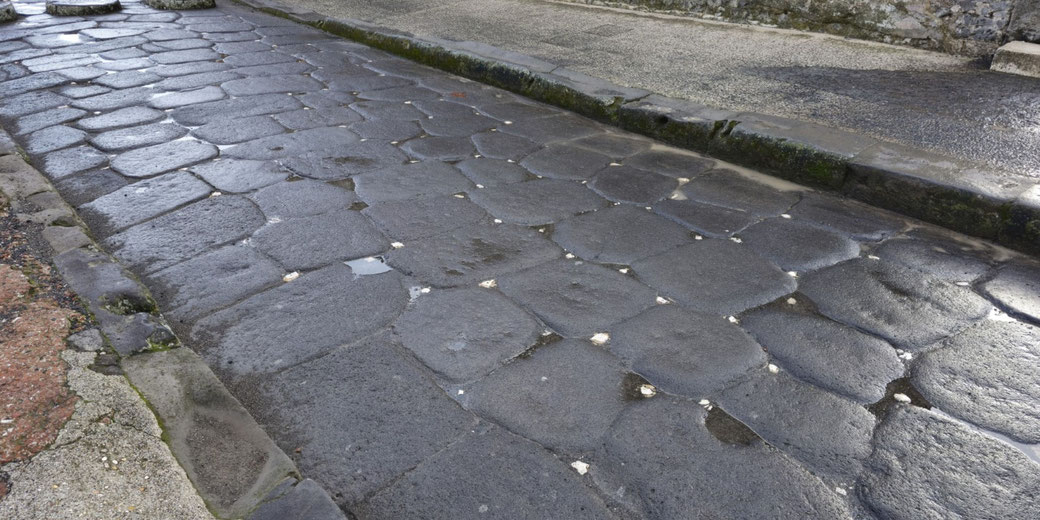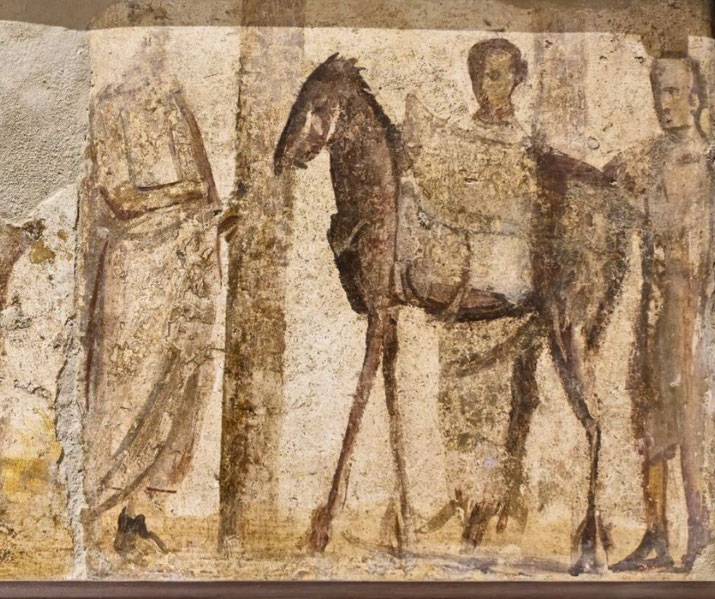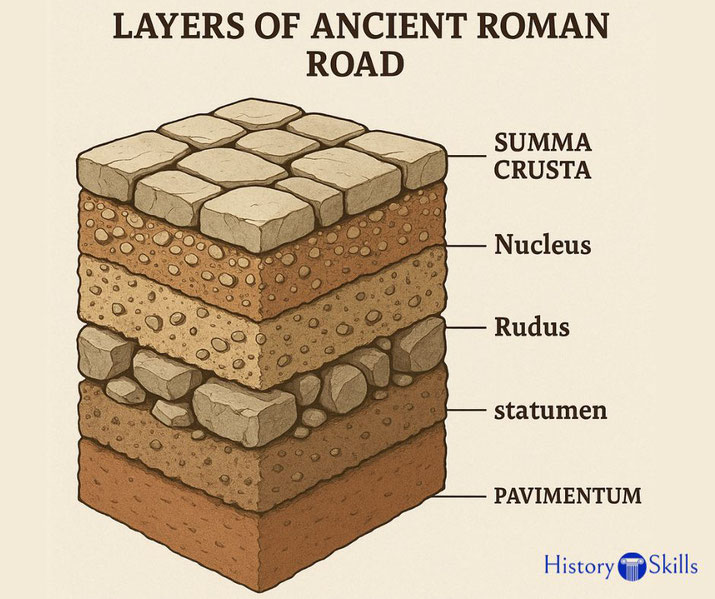How the engineering marvel of the Roman roads built an empire

When you step onto a modern highway, you may not realize that you are, in a sense, stepping back into history. The network of roads that lace across continents and countries today owe a significant debt to an ancient innovation: the Roman roads.
The vast and intricately planned road system of the Roman Empire not only facilitated its military triumphs, political control, and economic prosperity, but it also laid the foundation for the future of transportation infrastructure.
Over two millennia ago, the Romans built a web of roads stretching over 250,000 miles, reaching across three continents.
From the rainy highlands of Britain to the sun-soaked sands of Egypt, from the windy Atlantic coast of Iberia to the chilly banks of the Danube, the legacy of Rome was etched into the earth itself.
These roads were the arteries of the Empire, carrying soldiers, goods, news, and culture; they enabled Rome to govern and defend its vast territories and fostered economic growth and cultural integration.
How the network of Roman roads developed
The genesis of this system can be traced back to the earliest days of the Roman Republic, around the 4th century BCE, although it was during the era of expansion and consolidation of the Roman Empire, from the 1st century BCE to the 4th century CE, when the most significant advancements were made.
Roman roads served an array of strategic purposes that were critical to the formation and longevity of the Empire.
Primarily, they were constructed for military needs. The Romans recognized that in order to defend their sprawling empire, quick and efficient troop movement was imperative.
The roads served as rapid transit arteries that facilitated the speedy dispatch of legions to quell rebellions or respond to invasions.
In addition to their military function, Roman roads were instrumental for communication and commerce.
The ancient version of our modern post, known as the cursus publicus, relied on this extensive network for the dissemination of messages and official documents.
These roads also stimulated trade by connecting remote territories to Rome and each other, allowing goods to be transported far and wide.
Thus, wine from Gaul, olives from Hispania, and grain from Egypt could reach even the most distant corners of the Empire, fostering economic integration.
Roman roads also played a critical role in the administrative efficiency of the Empire.
The Empire's provinces were connected to the heart - Rome - ensuring effective governance, taxation, and law enforcement.
This improved communication and control over their vast territories, making the Roman Empire one of the most effectively administered states of the ancient world.

How were Roman roads made?
The ingenuity of the Romans is perhaps most visible in the design and construction of their roads, which was marked by remarkable engineering skills, meticulous planning, and a deep understanding of the local geography.
The Romans did not invent roads, but they brought a new level of organization, technical expertise, and ambition to their construction.
The characteristic feature of Roman roads was their straightness. Unlike other cultures that would build roads around obstacles, the Romans would make their roads as straight as possible, navigating over or through hills, marshes, and rivers.
This approach often involved significant engineering feats, such as the construction of bridges, viaducts, and causeways.
The straightness of the roads was not just for aesthetic or ideological reasons but had a practical value: it reduced the distance between places and made journeys faster.
The construction of Roman roads typically followed a standardized process, although variations occurred based on local topography and available materials.
The foundation would begin with the excavation of a trench, followed by the layering of materials.
At the bottom was the statumen, a layer of large stones, on top of which a layer of smaller stones or gravel, called the rudus, was placed.
Above the rudus came the nucleus, a mixture of gravel and lime or sand. The final layer, or the summum dorsum, was the surface of the road, typically made of tightly fitting, interlocking stones, providing a durable and hard-wearing surface.
This layered construction ensured good drainage and gave the roads their longevity.
The width of Roman roads varied according to their importance, ranging from a narrow track of about 1.2 meters to wider main roads of about 4.9 meters, enough for two vehicles to pass each other.
Some even wider roads were built to accommodate heavy traffic or military movements.
Roman roads were more than just tracks on the ground; they were complete transport infrastructures.
They incorporated features like milestones (miliarium) to indicate distances, resting places (mansiones) for travelers, and changing stations (mutationes) for horses.
These structures made long-distance travel across the Empire possible and efficient.

Famous Roman roads
The Roman road network comprised a multitude of routes, some of which are particularly notable due to their length, strategic importance, or the historical events they witnessed.
These renowned roads served as critical arteries of the Empire, facilitating efficient communication, trade, and military movement.
The most famous Roman road is undoubtedly the Via Appia, or the Appian Way. Regarded as the "queen of the long roads," it was named after Appius Claudius Caecus, the Roman censor who began and completed the first section as a military route in 312 BCE.
The road connected Rome to Brindisi in southeast Italy, serving as the main route for military supplies and officials traveling to the East.
The Appian Way was notable for its straightness and durability, and it was along this route that Spartacus and his slave revolt were famously crucified.
Much of the road is still in use today, a testament to its remarkable construction.
The Via Egnatia was another significant Roman road, traversing the Roman provinces of Illyricum, Macedonia, and Thrace.
Built during the 2nd century BCE, this road stretched over 500 miles from Dyrrachium (modern-day Durrës in Albania) on the Adriatic Sea to Byzantium (modern-day Istanbul in Turkey) on the Bosporus Strait.
The Via Egnatia was strategically important, connecting Rome with its eastern provinces and enabling the swift movement of legions to the Eastern front.
Another key road was the Via Augusta, also known as the Via Herculea, which was the longest road built by the Romans.
Starting from the Pyrenees, it stretched down the entire eastern coast of Hispania, today's Spain, and ended in Cadiz.
It was more than 1500 kilometers long and served as the backbone for the Roman control over Hispania.
Not to be forgotten is the Via Claudia Augusta, which linked the Adriatic Sea with the Danube River and thus opened a new way through the Alps from Italy to the central plains of Germany and the Elbe river.
This road was a crucial milestone, symbolizing the extent of Roman engineering prowess, as it entailed building a road over challenging Alpine terrains.
What was it like to travel on a Roman road?
The construction of the Roman roads was not just about providing a conduit for military operations, official matters, or trade.
In many ways, these roads came to define the rhythm of life in the Roman Empire, influencing both societal and cultural landscapes.
They played a significant role in everyday life, shaping commerce, fostering cultural exchange, and facilitating mobility and connectivity.
A journey along a Roman road would have been a vibrant experience. Trade thrived along these routes, and in the markets that sprung up in towns and cities, one could find a variety of goods from all corners of the Empire.
In the inns and taverns that were often located near these roads, travelers would rest, dine, and share news from their regions, leading to a lively cultural exchange.
The roads connected people from diverse cultures, ethnicities, and regions, creating a unique blend of traditions and ideas.
These thoroughfares also transformed the rural landscape. Villas, farms, and vineyards were built near major roads to facilitate easy transportation of agricultural produce to urban markets.
In fact, owning land close to a main road was a mark of prestige, and Roman aristocrats often had their grand villas built along these routes.
The roads also housed critical infrastructure for the comfort and convenience of travelers.
This included way stations (mutationes) and inns (mansiones or tabernae), placed at regular intervals, where travelers could rest, dine, change horses, or even stay overnight.
These establishments provided necessary services, creating a supportive infrastructure for those journeying across the Empire.
It is also worth noting that the presence of Roman roads often guided the development of towns and cities.
Many modern European cities owe their origin and early development to the Romans and their roads.
The roads provided a sense of connectivity and centrality, and settlements grew around these transport arteries, many of which evolved into significant urban centers over time.
Why the roads were so important to the Roman army
Roman roads were not just a feat of civil engineering or a means of promoting trade and communication; they were a critical component of Rome's military strategy.
Their role in facilitating swift and efficient movement of Roman legions across vast distances was a significant factor in the expansion, consolidation, and defense of the Roman Empire.
The very design and construction of these roads were driven by military needs. Their straight and wide paths, durable and all-weather surfaces, and the regular placement of way stations were all features designed to expedite military movements.
The legions could march quickly along these roads, and the presence of way stations ensured that they had regular access to supplies and rest, enabling them to maintain a high pace of movement over extended periods.
The roads also facilitated the rapid deployment of troops to troubled spots. Disturbances or invasions in remote parts of the Empire could be quickly addressed by dispatching legions from central locations.
The efficient road network meant that the time taken to move the army to a conflict zone was significantly reduced.
This ability to rapidly mobilize and deploy troops provided Rome with a strategic advantage in maintaining control over its vast territories.
Moreover, the presence of these roads also acted as a deterrent to rebellions. The visible reminder of Rome's ability to swiftly send in reinforcements would have likely made potential rebels think twice before rising against Roman authority.
The Roman roads also served as supply lines during military campaigns. They facilitated the movement of food, equipment, and other necessary supplies for the Roman army, thus enabling sustained military operations far from the Empire's core regions.
Finally, the road network facilitated the extension of Roman influence into newly conquered territories.
As the Romans expanded their territory, they would extend their road network, which in turn would facilitate further expansion.
The emperors used the roads to control the empire
One of the reasons the Roman Empire was so successful in maintaining control over its vast territories was its effective administrative system.
At the heart of this system was the extensive network of Roman roads. These roads did more than just facilitate travel; they served as the Empire's administrative backbone, aiding in governance, law enforcement, taxation, and communication across provinces.
With respect to governance, the roads allowed for efficient communication between the central government in Rome and provincial administrators.
Officials could travel rapidly across the Empire to enforce Roman laws, collect taxes, and manage local affairs.
The Roman postal system, known as the cursus publicus, relied on this network of roads for the speedy delivery of official correspondence, including laws, edicts, and military orders.
The road system also played a crucial role in taxation. The roads allowed for the easy transportation of goods, which could be taxed at various points.
Moreover, the efficient road network facilitated the collection of taxes by enabling tax collectors to travel quickly across the Empire.
The mobility provided by the roads made the administration of the Empire's complex taxation system feasible and efficient.
Furthermore, these roads enabled law enforcement within the Empire. Police and judicial officers could traverse the Empire swiftly, ensuring the enforcement of Roman law and maintaining order.
This rapid response capability helped in deterring crime and rebellion and allowed the Empire to effectively control its vast territories.
Roman roads also fostered a sense of unity and cultural integration within the Empire.
They allowed for the dissemination of Roman culture and language, reinforcing a sense of Roman identity across diverse populations.
This cultural integration further facilitated effective administration and control over the Empire's vast territories.
Why the roads fell into disuse
Like the Roman Empire itself, the once-glorious network of Roman roads eventually fell into decay and disuse.
The decline of these roads is intertwined with the fall of the Roman Empire and the onset of the Middle Ages.
The decline began with the financial crises of the late Empire. As resources became increasingly scarce, the maintenance of the extensive road network became less of a priority.
Without regular upkeep, the wear and tear of weather and constant use began to take their toll.
The road surfaces deteriorated, bridges fell into disrepair, and parts of the roads became impassable.
The reduced maintenance of the roads mirrored the overall economic decline of the Empire.
The situation was further compounded by the social and political instability of the late Roman Empire.
As the central authority weakened, the protection and security once provided along these roads declined.
Banditry became a problem, making travel along these roads risky. The efficiency and safety that had characterized the Roman roads for centuries were compromised.
The final blow came with the fall of the Western Roman Empire in the 5th century CE.
The invading barbarian tribes had little understanding of or respect for the Roman infrastructure.
Many roads were abandoned or fell into disuse, their strategic and economic significance largely forgotten. In the chaotic centuries that followed, the once-bustling network of Roman roads was largely reclaimed by nature or built over by subsequent civilizations.
Despite their decay and disuse, the remnants of the Roman roads continued to shape the European landscape.
Some of these roads remained in use, forming the basis for modern roads and highways.
Other roads guided the development of towns and cities, their ancient paths dictating the layout of modern streets.
Even in their ruin, these roads continued to connect people and places, echoing the grandeur of the Empire that built them.

How the modern world still uses Roman roadworks
One of the most direct and visible legacies of the Roman roads is their influence on modern road networks.
Many contemporary roads and highways, particularly in Europe, follow the same routes established by the Romans over two millennia ago.
These ancient paths have shaped the geography of modern transportation, influencing the locations and layouts of towns, cities, and even countries.
Some sections of the original Roman roads are still in use today, a testament to the durability and longevity of Roman engineering.
The Roman roads also significantly influenced urban development. Numerous modern cities, particularly in Europe, owe their origin and early development to the Romans and their roads.
These cities initially emerged as settlements along Roman roads or at their intersections, gradually growing in size and importance over centuries.
The ancient paths dictated the layout of these cities, influencing the arrangement of streets and landmarks.
The Roman roads also had profound cultural and societal impacts. They facilitated the spread of the Latin language, Roman law, and Roman culture across Europe, parts of Asia, and North Africa.
These influences are still seen today in the form of languages derived from Latin (the Romance languages), legal systems influenced by Roman law, and cultural and architectural remnants of the Roman Empire.
Beyond their physical and cultural impacts, the Roman roads have also left a significant symbolic legacy.
They serve as enduring symbols of the Romans' extraordinary engineering skills, their organizational capabilities, and their imperial ambition.
They stand as a testament to the might of the Roman Empire, its extensive reach, and its lasting impact on the world.
What do you need help with?
Download ready-to-use digital learning resources
Copyright © History Skills 2014-2025.
Contact via email
With the exception of links to external sites, some historical sources and extracts from specific publications, all content on this website is copyrighted by History Skills. This content may not be copied, republished or redistributed without written permission from the website creator. Please use the Contact page to obtain relevant permission.





